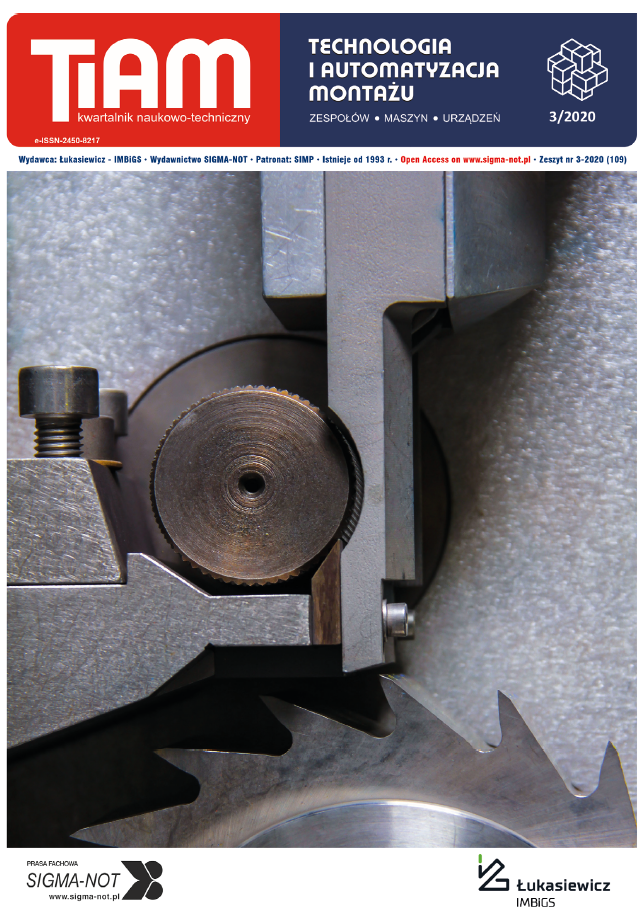Abstract
The paper presents the issues related to determination of the strength of the adhesive joints of C45 steel sheets which were made using six types of epoxy adhesives. Epidian 5, Epidian 53 and Epidian 57 epoxy resins and two types of curing agents: polyamide (PAC) and amine (Z-1) were used to prepare the epoxy adhesives compounds. The adhesive joints were subjected to strength tests in accordance with DIN EN 1465. When comparing the results of the shear strength tests of single lap adhesive joints of C45 steel sheet prepared with the use of the analyzed adhesives, it was noticed that better results were obtained with the use of the adhesive compounds containing the PAC curing agent.
This is an Open Access article distributed under the terms of the Creative Commons Attribution License CC BY 4.0 (https://creativecommons.org/licenses/by/4.0/)
References
Brockmann W., Geiß P.L., Klingen J., Schröder B. 2009. Adhesive bonding. Materials, Applications and Technology. Weinheim, Germany: Wiley-Vch Press.
Czaplicki J., Ćwikliński J., Godzimirski J., Konar P. 1987. Klejenie tworzyw konstrukcyjnych. Warszawa: WKŁ.
Czub P., Bończa-Tomaszewski Z., Penczek P., Pielichowski J. 2002. Chemia i technologia żywic epoksydowych. Warszawa: WNT.
da Silva L.F.M., Adams R.D. 2007. „Adhesive joint at high and low temperatures using similar and dissimilar adherends and dual adhesives”. International Journal of Adhesion and Adhesives (27): 216–226.
Fitton M.D., Broughton J.G. 2005. „Variable modulus adhesives: an approach to optimized joint performance”. International Journal of Adhesion and Adhesives (25): 329–336.
Godzimirski J., Kozakiewicz J., Łunarski J., Zielecki W. 1997. Konstrukcyjne połączenia klejowe elementów metalowych w budowie maszyn. Rzeszów: Oficyna Wydawnicza Politechniki Rzeszowskiej.
Katalog: Epidian: żywice i utwardzacze, https:// ciechresins.com [access: 01.10.2019].
Kuczmaszewski J. 2006. Fundamentals of metal- -metal adhesive joint design. Lublin: Politechnika Lubelska, Oddział PAN w Lublinie.
Prolongo S.G., del Rosario G., Ureña A. 2006. „Comparative study on the adhesive properties of different epoxy resins”. International Journal of Adhesion and Adhesives (26): 125 – 132.
Rudawska A. 2005. „Dobór rodzaju kleju w aspekcie wytrzymałości połączeń klejowych blach ocynkowanych”. Technologia i Automatyzacja Montażu (1): 28- 29.
Rudawska A., Cimek E. 2011. „Wpływ rodzaju kleju na wytrzymałość połączeń klejowych poliamidu PA6”. Przetwórstwo Tworzyw 17(3): 198–202.
Rudawska A., Kowalska B., Kubicki P. 2015. „Wytrzymałość połączeń klejowych polimerów, wykonanych za pomocą wybranych klejów sztywnych i elastycznych”. Przetwórstwo Tworzyw 21(4): 343-348.
Rudawska A., Kuczmaszewski J. 2012. „Badania porównawcze efektów modyfikacji żywic epoksydowych napełniaczami o dużym stopniu rozdrobnienia dla wybranych utwardzaczy”. Przetwórstwo Tworzyw 18(5): 500–504.
https://www.kronosedm.pl/stal-stal-c45-1-0503 [access: 01.10.2019].


